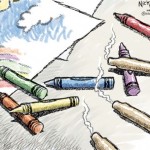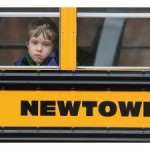In December of 2012, I wrote the following words. Not quite 3 years later, there have been 142 school shootings since the tragedy at Newtown. I can find no other, no better words than these to express what I’m feeling today: the anger and the sadness.
___________________________________________________________________________________________
More than a dozen years ago the horror of the Columbine tragedy changed my life.
It was that school shooting in April of 1999 and the subsequent Fort Gibson, Oklahoma school shooting that followed in December that set my life on the course it still holds.
Those tragedies indicated to me and a handful of colleagues that there was a breakdown of “community” occurring in our nation’s schools.
The discussion that followed led us to explore the possibility of expanding the outdoor education work we were doing to blend ecology with social science; to include activities that addressed interpersonal relationships and conflict resolution. Joined by many others along the way and along the years, we continue that work today at the Wildwoods Foundation.
 However, the 73 school shootings that have taken place since (that’s right, I said 73) tell us -despite our work and that of countless other organizations across this country dedicated to reducing violence- that this breakdown is still occurring and perhaps even accelerating.
However, the 73 school shootings that have taken place since (that’s right, I said 73) tell us -despite our work and that of countless other organizations across this country dedicated to reducing violence- that this breakdown is still occurring and perhaps even accelerating.
And now this.
In the last few days I have alternated between profound sorrow and frustrated outrage. I don’t suffer fools gladly on even my best of days, and so, compounded with a nasty cold I picked up during my Santa gig at Mayberry elementary (thanks kids!), the news from Newtown, Connecticut has firmly placed me in the most curmudgeonly of funks.
Is it really that hard to identify the causes of such horrendous tragedy? Especially when it now occurs across America on a somewhat regular basis. It is not a plague solely of the inner city nor of pseudo-calm suburbia. We know its face all to well, this “evil” that visited Sandy Hook Elementary School.
As the President pointed out in a speech this morning, dozens of people across our country (somebody’s friend or family) have died from gun violence in the days since the shooting in Newtown. With more than 10,000 US citizens that die each year from gun violence, that’s an average of more than 27 people killed everyday. Do we mourn for them too?
The other night, speaking at the multi-faith prayer vigil in Newtown, President Obama asked some pointed questions:
Can we honestly say that we’re doing enough to keep our children, all of them, safe from harm?
Can we claim, as a nation, that we’re all together there, letting them know they are loved and teaching them to love in return?
Are we really prepared to say that we’re powerless in the face of such carnage, that the politics are too hard?
Are we prepared to say that such violence visited on our children year after year after year is somehow the price of our freedom?
 The President went on to say, “We will be told that the causes of such violence are complex, and that is true. No single law, no set of laws can eliminate evil from the world or prevent every senseless act of violence in our society, but that can’t be an excuse for inaction. Surely we can do better than this.”
The President went on to say, “We will be told that the causes of such violence are complex, and that is true. No single law, no set of laws can eliminate evil from the world or prevent every senseless act of violence in our society, but that can’t be an excuse for inaction. Surely we can do better than this.”
As the representative of a not-for-profit organization, I must walk a fine line when it comes to advocating for specific policy change, but I think I occupy safe territory when I echo that simple statement.
Surely we can do better than this.
This will not be a task left to legislators and law enforcement officers. Many pundits have rightfully pointed to the mental health component of most mass shootings and the obvious gaps in our social safety net. The sad reality is that funding for and access to quality mental health services is diminishing across the country, particularly in schools where resources are stretched thin.
Surely we can do better than this.
At the Newtown prayer vigil, President Obama also said, “We can’t tolerate this anymore. These tragedies must end. And to end them,” he stressed, “we must change.”
And this change, I humbly submit, is where the rubber meets the road. I hail from rural North Carolina and I am constantly reminded by folks back home that not everyone in America thinks the way we do around here in my little corner of Los Angeles. Change is going to be harder for some than it will be for others.
While I am admittedly not a gun enthusiast, I do understand the patriot’s passionate defense of the second amendment. What I can’t understand, however, is why anyone thinks that this law was ever intended to extend the right to possess weapons of war capable of such massacre. I sincerely doubt that gangland warfare was what the Founding Fathers had in mind when they put forth the idea of “a well-regulated militia.”
Surely we can do better than this.
And to change, we must never forget what tragedies have come before. Some would say the USA is justifiably referred to as the United States of Amnesia. Any second now the 24/7 news cycle will relegate this tragedy to the back burner along with TMZ’s B-list celebrity scandals. The political will shall evaporate. Once McDonald’s re-re-introduces the McRib and the new season of American Idol launches, the Sandy Hook school shooting will be little more than a tragic footnote to 2012. Bread and circuses.
Surely we can do better than this.
At the press conference announcing the gun violence task force, the President said that, “If we’re going to change things … it’s going to take a wave of Americans … standing up and saying ‘enough’ on behalf of our kids.”
 That “wave” is going to have to consist of more than just those of us working in social welfare organizations. More than teachers. More even than parents, aunts, uncles and grandparents.
That “wave” is going to have to consist of more than just those of us working in social welfare organizations. More than teachers. More even than parents, aunts, uncles and grandparents.
At the prayer vigil, Obama asked if America was letting our kids “know they are loved and teaching them to love in return?” To this I would most definitely say that we can do better. We must admit that it takes a village. We must recognize the forces in society (economic and/or legislative) that impact the well-being of families; from living wage jobs to appropriate school resources to maintaining our social safety net. All of these contribute to a child knowing that they are safe and they are loved. All of these also contribute to public mental health and thus to improved public safety.
We can do better than this. I suggest that it’s up to each of us to decide how.
Summing up the challenge to conducting an adult conversation about gun violence, President Obama uttered what may well turn out to be one of the biggest understatements in history, “It won’t be easy,” and then he went on to deliver the most direct of truths, “but we can’t accept this as a reason not to try.”
While it will not be easy to attempt the dialogue about what can be done, the alternative of doing nothing is unthinkable. Surely there is some common ground that we can find that preserves our freedom and protects our kids.
We should be able to take our children to schools that don’t look like prisons. We should be able to shop at the mall without fear of the occasional mass killing. At the same time, law-abiding citizens should have the right to safely use firearms for sport or home protection. Why don’t we start there?
Because that’s better than where we are now. And surely we can do better than this.
Dwain Wilson
Founder & Executive Director
The Wildwoods Foundation
